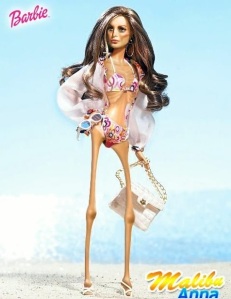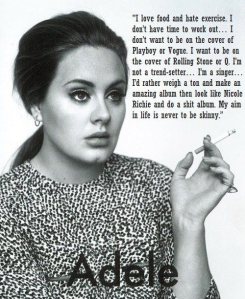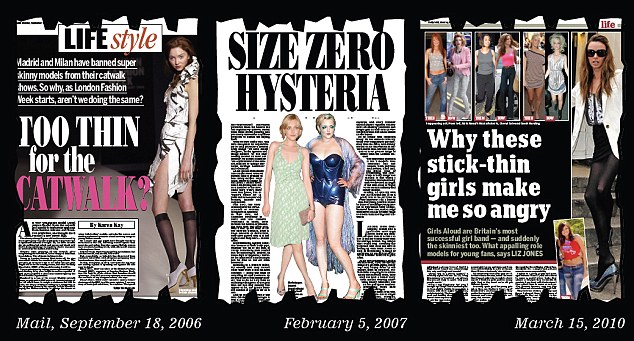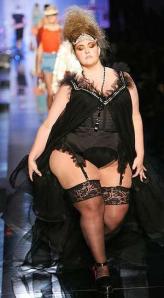Welcome back to Culture Critique! I hope you’ve enjoyed reading my last two blog posts, if not I hope you’ll find a spare few minutes to have a little catch up.
This week’s post is going to be exploring the frequently controversial topic of eating disorders being glamorized by the media and the affect that this has, even subconsciously, on people’s self-image and worth. Has self-consciousness, on a serious level, become something that everyone feels frequently? And is this due to the way in which models and celebrities are portrayed in the media? I think it’s important to explore the idea that without these ‘perfect’ images to aspire to, is it possible that people would be happy in their own skin? These are broad questions and ones that no-one will ever be able to answer simply, as the contributing factors are extremely complex, but it doesn’t mean we can’t delve into them and draw some of our own conclusions.
 To claim that people develop eating disorders, such as anorexia, because of the use of borderline anorexic models, is a bold statement, but not one that does not have overwhelming support. In America, the National Association of Anorexia Nervosa and Associated Disorders found that 70% of girls in high school said magazines influence what they see as ideals towards a perfect body. I can’t help thinking that this should not be surprising. Where else are young girls going to get the idea that you need to be thin to be beautiful? They never see anyone over a size 8 (UK) gracing their favorite mags, and education about weight / diet is non-existent, so why would they think any different? According to psychologist and contributor to the Huffington Post, if a woman “spends a lot of time looking at fashion magazines, this can be one of the factors that triggers feeling bad about her body, which she then turns into eating disorder behavior, like excessive dieting” – full article here.
To claim that people develop eating disorders, such as anorexia, because of the use of borderline anorexic models, is a bold statement, but not one that does not have overwhelming support. In America, the National Association of Anorexia Nervosa and Associated Disorders found that 70% of girls in high school said magazines influence what they see as ideals towards a perfect body. I can’t help thinking that this should not be surprising. Where else are young girls going to get the idea that you need to be thin to be beautiful? They never see anyone over a size 8 (UK) gracing their favorite mags, and education about weight / diet is non-existent, so why would they think any different? According to psychologist and contributor to the Huffington Post, if a woman “spends a lot of time looking at fashion magazines, this can be one of the factors that triggers feeling bad about her body, which she then turns into eating disorder behavior, like excessive dieting” – full article here.
And guess which group this affects the most? Yep… you guessed it… 12-20 year olds. The most impressionable and most exposed group of people to this crazy phenomenon; aspiration is a human trait experienced by everyone and without realistic images to aspire to, it’s no wonder so many people have such a low self-worth and feel the need to take action. In an article with the Daily Mail (here), Dr Jon Goldin supports this and argues that the use of thin models is not the only cause of eating disorders (obviously), but that the effects they have is widely mis-understood; “Children are influenced by what they see and if skinny models are seen as glamorous then there is a risk that young people may… seek to emulate them”. Sounds pretty straight forward right? It always strikes me that the people who employ these models are either ignorant to the effect of their promotion, or simply don’t care. The latter wouldn’t surprise me, after all, it’s not 15 year old girls buying their designer clothes, so why would they care? – What a horrible thought.
Now let’s up the controversy slightly more. Kirstie Clements, former editor of Australia Vogue (the biggest fashion magazine in theworld I might add), has revealed some shocking claims in her tell-all book, regarding the ways in which models balance between ‘life and death weights’. Whilst on a shoot, she noticed bruises and scarring on one of her models knees. When she asked her about them, the model casually revealed that it was because she was fainting a lot due to lack of eating. – Is it just me or are you over-whelmed by the glamour of the modelling industry right now? – I will never understand how behavior like this is normalised. The model was comfortable enough to reveal this to the editor of such a prestigious magazine, with no fear of reprimand, because in this industry starvation is not abnormal… isn’t this terrifying? – To read more of her interview, titled ‘Vogue editor says models think it’s ok to faint… eat tissues and go on hospital drips’, click here.
Is it worth attempting to assign blame for this ridiculous trend? I’m unsure. Blaming people will not change anything. The idea that, in order to be successful, you have to be as thin as possible is so embedded in the world’s opinions of models, that it is possible to suggest that this will never change. Will we wake up one day and see a size 14 (the UK’s average) woman on the front of all the top magazines? I doubt it, despite some fashion houses including Prada, Armani and Versace banning ‘size-0’ models from their shows. To put that into perspective, a US size 0 is a UK size 4. This means only models size 6 and above are deemed acceptable to hire, which is an important step towards healthier images being promoted to the world. Although size 6 is still very petite, it is surely heading in the right direction.
It’s important to try and look at this from the other side though – “It’s not my job to eat” a Russian model said to the VOGUE editor we discussed before, apparently one of the only sentences she could say in English. Although this is obviously in the extreme, must we remember that it is these models’ job to be well maintained? It would be possible that just as fireman have to be physically fit, models must manage their diets and exercise to achieve a body that models clothing well and promotes a certain image. The idea behind models being a small size, is that the clothes they wear hang on them, showing their natural shape and fit. I can wholeheartedly accept this, but just as in every aspect of life, there are always people who take it to the extreme!
Staying on the idea of extremes, when discussing the idea of how great it would be if the models gracing our covers were a ‘normal size’, someone I was with remarked “would you be encouraged to buy clothes if the model was fat?”. It’s one of those sensitive questions that you have to ask when talking about weight, but I can’t help think that everything is set to the very extreme. Why must it be polar opposite ends of the scale? Who decided that realism was unfashionable? 5 years ago Jean Paul Gualtier used a size 20 model in his catwalk show. Whilst I loved that he stuck two fingers up to the fashion world and I’m all for showing that beauty can be universal (I would have loved to have seen ‘fashionistas’ initial reactions), again everything seems to be done in the extreme, which is not a category that most of the population fall in to, therefor alienating most of the world.. I can’t say I will ever understand why this is deemed acceptable and promoted by the media and those who employ these dangerously thin models.
 Is that just it… would your average Jane not be encouraged to spend money if the advertiser looked just like her? Maybe the idea is that we are attracted to extreme difference. The idea behind spending a small fortune on a dress is that we are transformed into something different. Much like delving into a good book, maybe it’s a form of escapism and we are attracted by things we could only ever aspire to. Either way, it’s good to see that the way in which size-0 is portrayed is slowly changing into something negative. It’s one thing to eat right and exercise well, but it’s another to stop eating entirely, which is why the world needs to think twice when it promotes skeletal models.
Is that just it… would your average Jane not be encouraged to spend money if the advertiser looked just like her? Maybe the idea is that we are attracted to extreme difference. The idea behind spending a small fortune on a dress is that we are transformed into something different. Much like delving into a good book, maybe it’s a form of escapism and we are attracted by things we could only ever aspire to. Either way, it’s good to see that the way in which size-0 is portrayed is slowly changing into something negative. It’s one thing to eat right and exercise well, but it’s another to stop eating entirely, which is why the world needs to think twice when it promotes skeletal models.
I’ll end this post with Adele… “my aim in life is never to be skinny”. Wouldn’t it be marvelous if the majority of people in this world had more ambitious aims than simply fitting into a smaller dress size. Unfortunately we have become a world where in most cases, this is our biggest aspiration.
Thanks for reading!



Another well written and thought provoking article. These have become my must read blogs.
You’re onto something here Jen! Dont forget me when you’re famous. You hit the topic on the head! 🙂
Loving this article, highlighting the absurdity of the unrealistic and unhealthy ideal body shape for fashion models portrayed by the media.
Thought this was a great blog entry! You’re absolutely right… people are being made to grow up with unrealistic expectations of what their body should look like (which is worry for me as i have a nine year old sister who already throws lipstick in the general direction of her face) great post!
I found your blog post really interesting and agree with everything you have written. I think these models have a dangerous amount of influencial power over the majority of young women, who are already selfconscious of their appearance. Everywhere you look there’s an image of a beautiful, skinny model: in magazines, advertisements, the news. As a young woman myself I can sympathise with this pressure to be thin and conform to the medias idealistic view of women.
Great blog post!
Has the glamour of eating disorders always been prominent in our lives even from a young age? Your image of Barbie made me wonder whether “thin-ness” has always been encouraged. Barbie is a child’s toy recommended for use from the age of 3, with most children having stopped playing with them by their teens. A Barbie doll is physically inaccurate and would not be able to survive as a human being as explained in this video. http://www.youtube.com/watch?v=cVv-kmX6UOQ#t=99 The artist Nickolay Lamm created an average Barbie doll based on the average sizes and ratio of a 19 year old girl, so that young girls could see that “average is beautiful”. So why is the same not being done for the front of fashion magazines?
Though I am all for prompting a healthy lifestyle, I do not believe that using women excessively larger than the average (like you say the size 20 model) is setting a good image for young girls either. As undoubtedly it’s not healthy to be a woman of that size.
When your blog states “According to psychologist and contributor to the Huffington Post, if a woman “spends a lot of time looking at fashion magazines, this can be one of the factors that triggers feeling bad about her body, which she then turns into eating disorder behaviour, like excessive dieting” Although again I agree that in no way should these painfully thin girls be on the front of our fashion magazine I question whether the public should just take them for what they are, pictures. Pictures can be very easily manipulated and even so should seeing a thin girl on the cover of a magazine make a girl feel this way. We all have those “fat days” however it would have to take more than this I feel to make a person wish to self harm their body in such a way. I feel that personally it is more to do with an individual’s mental state than the glamorization although it can in no way be disregarded.